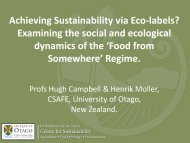Book of Abstract (incl. addendum) - IFSA symposium 2012
Book of Abstract (incl. addendum) - IFSA symposium 2012
Book of Abstract (incl. addendum) - IFSA symposium 2012
Create successful ePaper yourself
Turn your PDF publications into a flip-book with our unique Google optimized e-Paper software.
Workshop 6.4 Integrated simulation modelling in farming systems research<br />
statistical package to run models and analyse simulation outputs. The use <strong>of</strong> web interfaces enables<br />
application by non-scientist end-users.<br />
Participation begets integration: lessons learned from incorporating<br />
ethnography into linear programming<br />
David S. Wilsey, Thomas B. Gill, Alfredo A. Rios, Pete E. Hildebrand<br />
University <strong>of</strong> Minnesota, U.S.<br />
Dwilsey@umn.edu<br />
Over the last decade, Ethnographic Linear Programming (ELP) emerged as an innovative method to<br />
explore farmer responses to varied livelihood system “disruptions,” such as new technology, market<br />
interventions, and shocks. Modelers develop and use scenario-driven models that integrate social,<br />
ecological, and economic considerations <strong>of</strong> farm-based livelihood systems and strategies. ELP models<br />
have been developed for diverse livelihood systems across a broad geographic range. We analyzed<br />
three recent ELP modeling experiences to better understand and articulate the inherent strengths and<br />
limitations <strong>of</strong> the method. The three models reflected specific farming systems and addressed,<br />
respectively, the effect <strong>of</strong> HIV/AIDS on food security in western Kenya, commercial feasibility <strong>of</strong> a<br />
locally gathered palm in central Mexico, and potential adoption <strong>of</strong> ecologically based alternatives to<br />
chemical pesticides in highland Peru.<br />
ELP differs from linear programming in its use <strong>of</strong> ethnographic methods to capture, quantify,<br />
and integrate qualitative social considerations into biological and/or economic models. The greatest<br />
strength <strong>of</strong> the method was the use <strong>of</strong> participatory, ethnographic methods. Community participation<br />
has intrinsic value but also greatly enhances representation <strong>of</strong> diverse social agents and facilitates<br />
integration <strong>of</strong> social, economic, ecological, and political systems in the model, all <strong>of</strong> which enhance<br />
model validity. In addition, the modeling process was flexible and amenable to the modeler’s<br />
creativity. Conversely, participation increased time investments – in data collection and processing,<br />
model elaboration, and validation. Emphasis on intra-system rather than inter-system diversity limited<br />
broader application <strong>of</strong> the models. However, we recognize that the needs <strong>of</strong> academic researchers differ<br />
from those <strong>of</strong> field practitioners and expect that the latter could minimize observed limitations without<br />
substantial sacrifice to the numerous benefits outlined above.<br />
130











